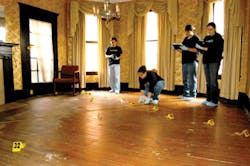524 5th Avenue looks like any other historic three-story brick home. Located about a block west of the Marshall University campus in Huntington, W.Va., a wide cement sidewalk leads up to the front steps of the white-columned porch. A large green bush flanks the left side of the front façade, obscuring one half of the porch as if the homeowners placed it to permit some privacy from passersby. The center window on the second story has two vertical panes with an ornate white carving fitted between; a frilly edged curtain can be seen peeking out. But no family resides here to dress the windows.
In a way, 1524 5th Avenue is a house of horrors. During any given week, a couple of its nine rooms are transformed into a mock crime scene, complete with shoe impressions in dust, spent bullet cartridges, life-like dummies as homicide victims and fake blood spatter.
The century-old building, bought by Marshall University in 2006, serves as a training ground for recreations of real-life scenarios. The house is used exclusively for crime scene training and hands-on educational experiences for a both novice and seasoned crime scene examiners, which educators say is key practice for the discipline. Forensic experts and law enforcement professionals say books and lecture are only one portion of the learning quotient for forensic courses.
Mock cases at Marshall
Marshall University has had a forensic science program for decades. But within the last couple years, the program was able to add what Terry Fenger says is essential for forensic education.
"Crime scene investigation and forensic science are very hands-on, applied disciplines," explains Fenger, director of the Forensic Science Center at Marshall. "You can talk all about these things in class, but unless you actually put the knowledge into practice, it has less meaning. So it's very important that you have mock cases you can work so that you can really experience the crime scene aspect of it."
The crime scene facility is part of Marshall University's Forensic Science Center, one of 28 programs accredited by the AAFS Forensic Science Education Programs Accreditation Commission (FEPAC). Fenger explains the program dates back to 1993, but in recent years the grant-funded crime scene house and training provided by the FBI were added, providing in-service instruction for practicing crime scene investigators and related law enforcement personnel from across the United States.
"Like with every other field, there are always new improvements, discoveries and techniques evolving [in crime scene investigations]," Mary Thomasson, MUFSC press information officer, says.
On the academic side, Fenger explains the program has on average about 20 students graduate per year across four areas of emphasis: crime scene investigation, forensic chemistry, forensic DNA technologies and computer forensics.
Technology in play
The house offers more than crime scene staging space. In addition to the main floor, which hosts much of the mock crimes, the house has a latent print lab, a blood-spatter room and a simulated methamphetamine lab scene that includes a bathtub. Students use various technologies to collect and record the scenes. Traditional CSI tools such as impression lifters, alternative light sources to detect stains, digital cameras and broken glass impact assessments are used. Fenger utilizes the crime scene house space for digital forensics instruction, too. Cell phone forensic basics have been covered where students train using digital evidence collection tools like CelleBrite's cell data recovery kit. Investigating wireless routers and signal origination is also reviewed, for example. Learning that all of these are possibilities to discover and collect evidence is emphasized.
"[Students are taught] to determine if there's a wireless system in play, even though the main computer is located in a particular room," Fenger says. "There could be a wireless router at a different location in connectivity to other places or the outside world."
The main floor is also wired with a CCTV system — including 360-degree motorized cameras — that is used to monitor mock scenes, record them digitally for review and critique of investigative methods later with professors.
Hands-on lessons
Crime scene investigation work can be delicate, and there are several slips an incoming student can make. When dealing with evidence, proper care and consciousness need to be taken to preserve the scene. The crime scene house allows students to take what they've covered in texts and classroom instruction and apply it to a mock investigation. Fenger says the hands-on process can help students learn from mistakes and makes for a more savvy examiner.
Fenger adds students are first taught to recognize the evidence. For example, in one mock investigation at the crime scene house, he says there was a dusty floor and the perpetrator had stepped and left his shoe impression in the dust.
"If you're not aware of that possibility, in the case I'm thinking of, the students walked right through the dusty impressions and destroyed the evidence," he explains. "The correction was to step back, take your flashlight at an oblique angle and look for these type of impressions before you enter the crime scene. In other words, don't destroy evidence."
In another mock crime scene house investigation, students had run through and completed the exercise. On review, Fenger showed them they had missed a USB drive pen that contained all kinds of information relative to drug transactions, which had been inconspicuously resting in a cup on a desk.
"Even though I had shown them ... in one of my lectures that these types of devices can look like a pendant on a necklace or a small stuffed animal, they were not able to discern that this pen had a thumb drive in it," Fenger says. "When they realized it, it was like a light bulb went on and they were much better at finding digital evidence."
The house sees not only an assortment of robbery, drug busts, assaults and homicides, but also all sorts of visitors. In addition to the MU crime scene degree students, the house also hosts FBI-sponsored training events, high school students, and is utilized by the Huntington Police Department.
Borrow from your neighbor
The Forensic Science Institute at the University of Central Oklahoma also offers a unique education and training environment. UCO had been offering an academic program in forensic science for nearly 30 years. In 2006 the university created the Forensic Science Institute, which provided continuing education for forensics-related professionals. The UCO forensic program director, Dwight Adams, says the Forensic Science Institute put on more than 30 training programs for law enforcement and forensic science professionals. The university wanted to broaden the scope of its program and create a center of excellence for forensic science on campus. This past fall, the Institute took over the forensic academic program and opened a brand new facility that is connected to the Oklahoma State Bureau of Investigation, housed right next door.
Adams, formerly director of the FBI laboratory in Quantico, Va., for 23 years retired from the FBI in 2006 and began working with the University of Central Oklahoma — his alma mater — to create the Forensic Science Institute. He says the university's forensic science center and state bureau augment each other, creating an advantageous partnership. Students in the UCO forensics program benefit from the expertise next door at the Oklahoma State Bureau of Investigation through internships.
"The students look at those across the street as mentors and something they aspire to do themselves," Adams says. "The relationship has been absolutely wonderful in terms of what OSBI has contributed to this program and what we in turn have been able to provide back to them." OSBI benefits from having a ready-made pool of applicants for job openings — in fact, the current director is a UCO graduate.
Part of UCO's dedicated crime scene simulation space includes an evidence recovery bay, which was designed and built into the new building exclusively for that purpose. Adams explains the area is used much like a garage in that instructors don't worry about fingerprint powder or blood stain pattern analysis or getting a classroom dirty.
The university also owns a former hospital building that is made available exclusively for forensic science and has multiple rooms. The OSBI has used the crime scene hospital to stage a school shooting scenario, and UCO students recently staged a stabbing scene, which included evidence like the knife, fingerprints, shoeprints in blood, hairs and fibers.
Living stories
Steps are taken today to secure accredited forensic disciplines and enhance the hands-on training available to the up-and-coming generation, like the applied sciences are at the forefront of the crime scene house's initiative.
In the crime scene house, MU students are able to iron out the investigation kinks and capabilities to complement the methods they study in class and textbooks.
Despite the robberies, drug busts and death investigations the house is privy to, the three-story dwelling remains alive, bustling with students, staff and science each week.
Free FBI training at MU
Marshall University Forensic Science Center is also host to free forensic-based FBI training courses. The FBI Laboratory Specialized Training Program sponsors several crime scene, handwriting examination and tire and foot impression courses between one to two weeks long. Accepted applicants have lodging, meals and transportation to the training location paid by the FBI.
Courses are open only to law enforcement, government agencies and public crime laboratory personnel. Courses are scheduled to take place this year from March to September.
To apply, visit forensics.marshall.edu/Projects/FBI-CSI.html and fill out an application form to submit via e-mail. Applications must be submitted one per course at least 60 days prior to the course start date.

Tabatha Wethal | Editor
Award-winning writer Tabatha Wethal is a previous editor leading Law Enforcement Technology magazine and assisted with other publications. She was with the magazines since 2007.



